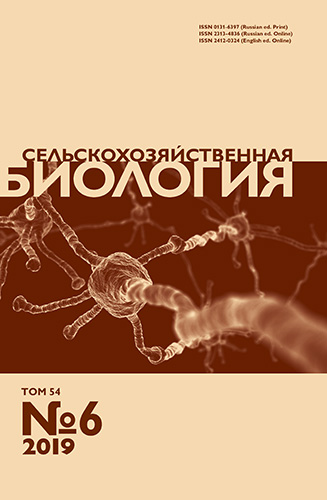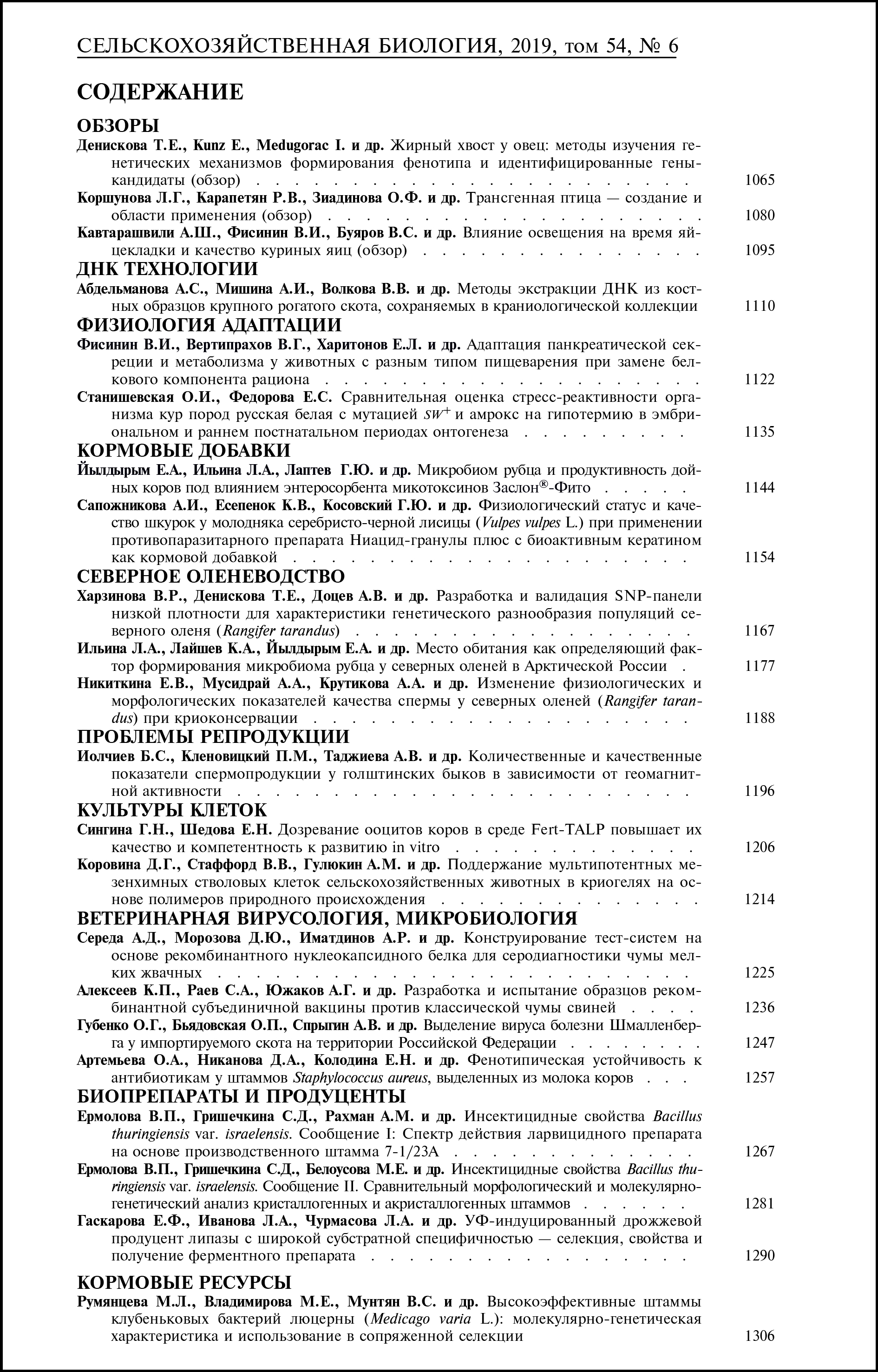doi: 10.15389/agrobiology.2019.6.1267rus
УДК 579.64:632.937.15
При выполнении исследования использовалось оборудование ЦКП «Геномные технологии, протеомика и клеточная биология» ФГБНУ ВНИИСХМ. Работа поддержана проектом прикладных научных исследований и экспериментальных разработок (ПНИЭР) по лоту шифр 2017-14-579-0030 по теме: «Создание микробиологических препаратов для расширения адаптационного потенциала сельскохозяйственных культур по питанию, устойчивости к стрессам и фитопатогенам» (шифр заявки 2017-14-579-0030-013), Соглашение № 14.607.21.0178, уникальный идентификатор работ (проекта) RFMEFI60717X0178.
ИНСЕКТИЦИДНЫЕ СВОЙСТВА Bacillus thuringiensis var. israelensis.
Сообщение I: СПЕКТР ДЕЙСТВИЯ ЛАРВИЦИДНОГО ПРЕПАРАТА
НА ОСНОВЕ ПРОИЗВОДСТВЕННОГО ШТАММА 7-1/23А
В.П. ЕРМОЛОВА1, С.Д. ГРИШЕЧКИНА1, А.М. РАХМАН2,
К.С. АНТОНЕЦ1,М.Е. БЕЛОУСОВА1, В.В. ЯХНО1, А.А. НИЖНИКОВ1
Кровососущие комары и мошки из отряда Двукрылые (Diptera), которые участвуют в передаче ряда опасных инфекционных заболеваний животных и человека, относятся к объектам санитарно-эпидемиологического и ветеринарно-эпизоотологического контроля. Воздействие этих насекомых снижает продуктивность сельскохозяйственных животных (удои молока, яйценоскость кур) и даже может приводить к их гибели. Проблема биозащиты от вредных насекомых крайне актуальна и в растениеводстве, в том числе при выращивании сеяных кормовых культур. В качестве основы для биологических инсектицидов — современной экологически и социально приоритетной альтернативы химическим пестицидам — в настоящее время широко используются спорообразующие бактерии Васillus thuringiensis Berliner (Bt). Против кровососущих и растительноядных комаров разработана и получена жидкая форма ларвицидного препарата на основе оригинального штамма B. thuringiensis var. israelensis 7-1/23А (ФГБНУ ВНИИСХМ; депонирован в Ведомственной коллекции полезных микроорганизмов сельскохозяйственного назначения RCAM ФГБНУ ВНИИСХМ под регистрационным номером RCAM 00626, патент РФ 2539732 от 09.12.2014). В состав жидкой формы препарата входит спорокристаллический комплекс, 5 % NaCl (консервант), 2 % хвойного экстракта (отдушка), остатки питательной среды; титр — 4,25×109КОЕ/мл, ларвицидная активность, выраженная в ЛК50 для личинок Aedes aegypti IV возраста (L4), — 0,11×10-3 % (тест согласно рекомендации Всемирной организацией здравоохранения, WHO). Штамм BtH14 7-1/23А ранее выделили из пробы, взятой в анофелогенном водоеме в Ленинградской области, изучили его физиологические и культуральные особенности и охарактеризовали согласно классификации De Barjac и Bonnefoi. В настоящей работе впервые выполнен комплексный анализ ларвицидного препарата на основе BtH14 7-1/23А, включающий молекулярно-генетическую характеристику продуцента, определение ларвицидной активности в отношении ряда вредных двукрылых, а также оценку его влияния на рост и развитие нецелевых объектов (мицелий вешенки и шампиньона). Проведенное секвенирование гена, кодирующего В-субъединицу ДНК-гиразы gyrB, подтвердило, что штамм 7-1/23А представляет собой B. thuringiensis var. israelensis. Наличие генов cry4 и cry11, кодирующих белковые инсектицидные токсины, было установлено с помощью ПЦР-анализа. Мы изучили спектр действия препарата как против кровососущих комаров родов Aedes, Anopheles, Culex, так и против вредоносных растительноядных двукрылых — рисового (Сricotopus sylvestrisFabr.) и грибного (Lycoriella fucorum Frey) комариков. Анализ, выполненный в лабораторных и полевых условиях (2014-2016 годы, Ленинградская и Московская области, Краснодарский край, аедогенные, анофелогенные водоемы, сырые цокольные помещения, рисовые чеки), включал также изучение влияния препарата на рост мицелия съедобных грибов — вешенки (Pleurotus ostreatus) и шампиньона (Agaricus campestris) как биоэкоиндикаторов. При лабораторной оценке эффективности препарата против комаров родов Culex и Аеdes величина ЛК50 составила 0,11×10-3-0,12×10-3 %, ЛК50 для L4 Anopheles maculipennis Meigen равнялась 0,29×10-3 %. Полевые испытания в водоемах против малярийного комара (Anopheles maculipennis) и немалярийных комаров рода Aedes (communis, dorsalis, punctor, caspius, flavescens), в сырых цокольных помещениях против Culex pipiens molestus Linnaeus, на рисовых чеках против Сricotopus sylvestris Fabr. показали 90,2-100 % гибели личинок. При этом в концентрации 5 % препарат стимулировал рост мицелия грибов на 28,2-32,5 %. Сравнение действия биопрепарата и химического инсектицида — ингибитора синтеза хитина Димилина (Dimilin, «Arysta LifeScience S.A.S.», Франция) против личинок грибного комарика семейства Lycoriidae (Lycoriella fucorum Frey) в рекомендованных дозах раздельно и сниженных — при совместном применении показало, что сочетание препаратов при 4-8-кратном снижении их доз вызывало гибель 97,2 % личинок с прибавкой урожая на 38,6 %. Таким образом препарат на основе BtH14 7-1/23А перспективен для санитарной экологии и ветеринарии, кроме того, целесообразно изучить возможности его применения против насекомых — вредителей сеяных кормовых культур.
Ключевые слова: Bacillus thuringiensis var. israelensis (ВtH14), титр, ларвицидная активность, ростстимулирующая активность, биологический препарат, токсины Cry.
V.P. Ermolova1, S.D. Grishechkina1, A.M. Rakhman2, K.S. Antonets1,
M.E. Belousova1, V.V. Yakhno1, A.A. Nizhnikov1
Blood-sucking mosquitoes and blackflies belonging to the order Diptera cause sanitary-epidemiological and veterinary-epizootological damages in humans and animals and serve as the carriers of various dangerous transmissible diseases. The productivity and milk yield of livestock as well as egg production in poultry birds are significantly affected by harmful Diptera species. The problem of bioprotection from harmful insects is extremely relevant in crop production, including the cultivation of seeded fodder crops. Currently, the spore-forming bacterium Bacillus thuringiensis Berliner (Bt) represents the most common agent for biological control of the number of insect species and is considered as the basis for the production of insecticides. Biological preparations are of particular importance due to their significant advantages over chemical pesticides and are considered in modern agricultural systems as environmentally and socially beneficial alternatives to agrochemicals. A liquid form of larvicidal preparation against blood-sucking and herbivorous mosquitoes based on the original strain Bacillus thuringiensis var. israelensis 7-1/23А was developed at the ARRIAM. Under registration number RCAM 00626 (RF patent 2539732 dated 12/09/2014), the strain was deposited in the ARRIAM Collection of beneficial agricultural microorganisms (RCAM). The composition of the liquid form of the biopreparation includes a spore-crystalline complex, 5 % sodium chloride, 2 % coniferous extract (as a preservative and perfume, respectively), and the remains of a nutrient medium. The titer was 4.25×109 CFU/ml. Larvicidal activity expressed in LC50 for Aedes aegypti IV instar larvae was 0.11×10-3 % (biotest proposed by the World Health Organization). The strain was previously isolated from an anophelogenic reservoir in the Leningrad region, studied for physiological and cultural features, and characterized according to Н. De Barjac’s and А. Bonnefoi’s classification. In this work, for the first time, a comprehensive analysis of a larvicidal preparation based on BtH14 7-1/23A was performed, including the molecular characterization of the strain, determination of its larvicidal activity against a number of harmful dipterans, and an assessment of its effects on the growth and development of non-target objects (oyster mushroom mycelium and champignon). Sequencing of the gene encoding B subunit of the DNA gyrase (GyrB) confirmed that the isolated strain belongs to B. thuringiensis var. israelensis. The presence of the cry4 and cry11 genes encoding protein insecticidal toxins was detected by PCR analysis. We also studied the spectrum of action of the larvicidal biopreparation against the blood-sucking mosquitoes of the genera Aedes, Anopheles, Culex, and harmful herbivorous dipterans: rice (Сricotopus sylvestris Fabr.) and mushroom (Lycoriella fucorum Frey) flies. The analysis was carried out in laboratory and field conditions (2014-2016, Leningrad and Moscow regions, Krasnodar Territory, aedogenic, anofelogenic ponds, raw basement rooms, rice checks) and also included an assessment of the effect of the preparation on the growth of mycelium of oyster mushrooms (Pleurotus ostreatus) and champignon (Agaricus campestris) as bio-eco indicators. LC50 values in laboratory tests were 0.11×10-3 and 0.12×10-3 % for Culex and Аеdes, respectively, and 0.29×10-3 % for Anopheles maculipennis Meigen. Field tests in water reservoirs against malarial (Anopheles maculipennis) and non-malarial mosquitoes of the genus Aedes — communis, dorsalis, punctor, caspius, and flavescens; in moist basement rooms (Culex pipiens Linnaeus f. molestus Forskål), rice fields (Сricotopus sylvestris Fabr.) showed 90.2-100 % mortality of larvae. The effect of the biological preparation on the growth of mycelium of oyster mushrooms and champignon was studied in three concentrations (5, 10, and 20 %). The most efficient was 5 % concentration which stimulated the growth of fungal mycelium by 28.2-32.5 %. The analysis of the separate and combined applications of the 7-1/23А-based biopreparation and the chemical insecticide, chitin synthesis inhibitor Dimilin («Arysta LifeScience S.A.S.», France) against the larvae of the mushroom fly of the family Lycoriidae (L. fucorum Frey) demonstrated that combined use of these insecticides in 4-8 times reduced dozes caused death of 97.2 % larvae and led to an increase in the yield by 38.6 %. Thus, a preparation based on the BtH14 7-1/23A is promising for sanitary ecology and veterinary. In addition, it is advisable to study the possibilities of its use against insect pests of seeded forage crops.
Keywords: Bacillus thuringiensis var. israelensis (BtH14), titer, larvicidal activity, growth-promoting activity, biologiсal preparation.
1ФГБНУ ФНЦ животноводства — |
Поступила в редакцию |












